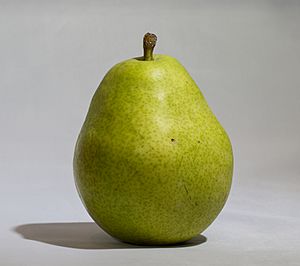D'Anjou facts for kids
The D'Anjou pear is a popular type of fruit. It is also known as the poire d'Anjou or Beurré d'Anjou. This pear belongs to the Rosaceae family, which also includes roses and apples. D'Anjou pears first came from Anjou, a region in France. They are often more affordable than some other types of pears. D'Anjou pears are known for their mild sweetness.
Contents
Discovering D'Anjou Pears
D'Anjou pears are a favorite choice for many people. They are great for eating fresh, adding to salads, or cooking. Their smooth skin and juicy flesh make them a versatile fruit.
Where Do D'Anjou Pears Grow?
The D'Anjou pear originally comes from the Anjou region of France. Today, these pears are grown in many places around the world. Major growing areas include the Pacific Northwest region of the United States. This area has the right climate for growing healthy pear trees.
What Makes D'Anjou Pears Special?
D'Anjou pears have a unique shape. They are usually short and round at the bottom, tapering to a narrower top. They are known for their juicy, firm flesh. While they are not as sweet as some other pears, their mild flavor is perfect for many dishes. They are also often less expensive, making them a great choice for families.
Green Anjou vs. Red Anjou
There are two main types of D'Anjou pears you might see:
- Green Anjou: This is the most common type. It has a bright green skin. As the pear gets ripe, its skin may turn a slightly yellowish-green color.
- Red Anjou: This variety has a beautiful deep red skin. The red color tends to get darker as the pear ripens. Red Anjous taste very similar to Green Anjous.
How to Know When a D'Anjou Pear is Ripe
Unlike some other fruits, D'Anjou pears do not change color much when they ripen. The best way to check if a D'Anjou pear is ready to eat is to gently press near the stem. If it gives a little, it means the pear is ripe and ready to enjoy! If the whole pear feels soft, it might be overripe.
Images for kids
See also
 In Spanish: Pera de Anjou para niños
In Spanish: Pera de Anjou para niños



